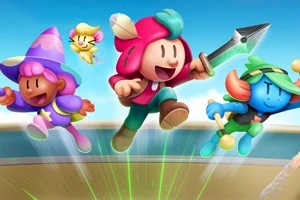Feature: From You To Mii #2

Posted 01 Jun 2008 at 12:10 by Tom Phillips

In the concluding half of his study on Nintendo's characters, Mark Lee charts the evolutionary process which brought us the Mii, and looks to the future...
Written by Mark Lee
In part one, we saw how Nintendo have created characters ever since the company's inception as a card manufacturer. So how has the company continued this into the era of 3D?
Say Cheese! Gaming goes 3D
When the Nintendo 64 came around in 1996 Nintendo obviously thought they had enough processing power to let gamers themselves create their own characters. The Talent Studio series points to the fact that fresh ‘character’ ideas still lay within Miyamoto’s cranium - ideas that user-created experiences would power future titles. In fact the Talent Studio line of games enabled players to insert captured pictures into their N64 using the N64's Input Cartridge and transfer them into fully animated 3D models.

The rare N64 Input Cartridge.
Putting these “user created” characters in classrooms and parks was hyped for many years at E3 and Spaceworld events and the infinite possibilities of user-created content were poured over. Yet after all of the talk and hype, Talent Studio never fully materialised, and even though it was shown at a much later date on both the 64DD (and later as Stage Debut on the Gamecube) the title nor ideas never truly saw fruition.

The Stage Debut E3 demo, showing the never-released title running on the GameCube.
As user-created content was touted for the 64DD, surprisingly, what was released (worldwide) was an application for the ageing Game Boy - the truly excellent Game Boy Camera. Taking pictures of yourself and animating them was surprisingly great fun and it was easy to share with rolls of printer paper. Hidden in that title was a mixture of the best user created content seen in years.

The Game Boy Camera, which offered up some hilarious moments in our youth.
In fact, the Camera was such a success that Nintendo even planned a GBA version. Called GameEye, it would take full-colour photos and feature connectivity with the GameCube. It would also connect to Stage Debut for a more advanced feature set than previously shown on the N64. Again, these ideas never saw fruition. It seemed that games shown alongside the Talent Studio/Stage Debut monikers were far too ambitious for their own good. Surprisingly then, the only other such title shown for the N64 was Animal Forest.
Just like the Talent Studio titles, Animal Forest indicated user-created content in line with the 64DD’s promises. And boy did it deliver. At a later date the title was ported to the Gamecube and released worldwide - as Animal Crossing. Offering only slight adjustments to the N64 original and the ability to play classic NES games, the title was a landmark in user-created character development. It’s fair to say that the main character is obviously represented as the mirror image of the player - which makes the “he’s a plumber like normal people” mantra seem archaic in comparison.

Tom Nook: Showing that Nintendo still create characters relevant to the real world.
Having spent a good five years trying to meld user created character creation and development into a “fun” experience, it was surprisingly Animal Crossing which would go on to really power it all home. And those aftershocks can be felt even in the very core of the Wii’s Mii system.
From You to Mii
So after all of this development we have to ask: “Why is the Wii’s character creation system so...Limited?” After spending so long pushing for user interaction with characters, and having created some of the best characters ever, why does the Mii system feel so... shallow?
Long time fans know that Nintendo always aim to keep players on a level playing field, yet not having the opportunity to douse your own avatar with clothes and personal items means the Mii system lacks real emotional attachment.

The ability to pimp up your Mii was unfortunately not included.
Indeed, we see the Mii system reduced to cameo status in flagship titles such as Mario Kart and Wii Fit with only minor costume changes. Recently Namco Bandai have been allowed to alter Mii’s in We Ski yet hats and goggles aren’t a possibility. This wouldn’t be too bad but even the costume change is severely limited. Draw comparison to My Sims and you can see that clothes can make a massive difference if designed with enough detail. We have one theory why the Mii system is so limited...


Nintendo's original avatar program betas, on the DS, and even as far back as the Famicom Disk System.
Couple the idea of “recycled” development with the somewhat crippling memory size of the Wii and we think that the Mii idea is meant to be a small stepping stone. Something which will see fruition in another five years time. Nintendo are still evolving. Nintendo’s competitors are also now punching into personalisation and avatar ideas - and we wonder how long it will be until every system comes with personalisation as standard. With internet and identity (both online and off) being of far greater importance in gaming than ever before, from you to me, the future of gaming lies (literally) in our hands.
Written by Mark "Tapedeck" Lee
-N-Europe Staff Writer






















